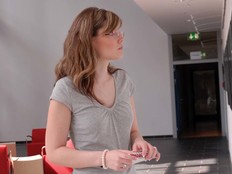Digital Signage Grabs Students' Attention Better Than E-mails
The Southern California Institute of Architecture uses digital signage to keep students and faculty in the loop.
Distributing important or time-sensitive information shouldn’t be a problem at the Southern California Institute of Architecture in Los Angeles. Every student and faculty member has a school e-mail account, a hardwired Internet connection and access to the campuswide wireless network. But there’s a big difference between sending a message and making sure the news gets out to members of the SCI-Arc community, says IT Director Vic Jabrassian. A new ViewSonic digital signage system helps fill that gap, grabbing the attention of students and faculty alike, Jabrassian says.
“Using e-mails to communicate with students, and even faculty, on a consistent basis just doesn’t work,” he says.
“They have so many accounts and so much going on with their work that there’s a lack of interest in general e-mails,” Jabrassian says. “Digital signage gives us the opportunity to keep students up to date, and there’s much more potential with streaming video and multimedia.”
Students were initially reserved in their response, but are increasingly interested in the displays. Many now want to be involved in creating content, Jabrassian says.
“The students here want to become architects, so it makes sense that they feel comfortable with visual communication,” says Network/Systems Administrator Vance Lanoy. “The displays just make it easier for them to keep up.”
For now, plans include streaming or rerunning lectures and seminars on the screens, but other uses are being considered. The screens are so compelling that SCI-Arc staff must be careful that they don’t distract from school work, says SCI-Arc Director Eric Owen Moss.
“We want to understand and exhaust the possibilities of the technology, not just to present announcements but to deliver educational content,” says Moss. “It’s already made an important contribution, and we think it can do more.”
For Architects Only
Making the most of technology’s potential is important at SCI-Arc, a unique institution with about 500 highly motivated students in bachelor’s and graduate programs. The faculty is made up entirely of trained and practicing architects.
“This is a school with a lot of life and a lot of energy, and it’s useful to distribute information in a way that matches that energy,” Moss says.
The academic atmosphere at SCI-Arc is intense and standards are high for everyone, including the three-person IT staff, says Jabrassian, who graduated from SCI-Arc before he made the career switch from architecture to IT.
“We try to keep the department and the technology we provide as cutting-edge as possible,” he says. “We need to be in sync with the philosophy of the place.”
The Right Stuff
Jabrassian and his staff began researching digital signs in early 2008. Baseline criteria included high-resolution screens and the ability to incorporate streaming video and Flash presentations. Moss supported the project, and no specified budget limit was set, but keeping costs down was a priority for Jabrassian. He also had to consider the unique aspects of SCI-Arc’s downtown Los Angeles campus, which is housed in a renovated railroad freight depot that’s about a quarter-mile long.
Based on their research, Jabrassian and his staff weighed a number of options in addition to ViewSonic, including systems from Cisco, Panasonic and Samsung. In early August 2008, SCI-Arc ordered nine 42-inch ViewSonic CD4220 LCD screens with ViewSonic SPK-009 speakers, 11 ViewSonic NMP-530 digital multimedia receivers, and 11 Best Wave DisplayIt! software packages to deliver content.
The CD4220 displays are designed for use in public spaces, where ambient light can vary significantly. The LCD screens provide 1500-to-1 contrast ratio, 500 brightness (nits) and 1360x768 pixel resolution. The compact 7-inch by 5-inch by 1-inch NMP 530 multimedia receivers, which eliminate the need for a PC at each signage location, come with built-in Macromedia Flash 6 and support MPEG-1/2/4, as well as WAV audio/video formats. It’s possible to run multiple display screens from an NMP 530, but SCI-Arc chose to have one multimedia receiver per screen so it could vary content from location to location.
Content for the system is created and scheduled using Best Wave DisplayIt!, which offers a straightforward interface for nontechnical users, templates and shared libraries to facilitate content creation, as well as streamlined administration and security features.
Ready or Not?
SCI-Arc took its time researching systems to make sure it chose the right one, but a late-summer buying decision left little time for deployment before the start of the classes, Jabrassian says.
A Small Price to Pay
The cost of the Southern California Institute of Architecture’s digital signage system included the state’s electronic waste recycling fee: $10 for each LCD. California is one of 18 states that have passed laws to regulate or help pay for the recycling or cleanup of e-waste.
In addition to state regulations, counties and municipalities across the country, including New York City, have passed local ordinances aimed at keeping lead, mercury, cadmium and other harmful substances in electronic equipment out of the environment.
While laws addressing e-waste management by smaller government entities are welcome steps, the result is often a confusing hodgepodge of regulation. For example, while California charges a fee to the purchaser of the electronic equipment of $8 to $25 per screen (depending on screen size), Maryland requires manufacturers of the equipment to register and pay a fee. Other jurisdictions mandate the establishment of recycling programs or stipulate recycling volumes as a percentage of sales for manufacturers.
“There’s no federal law yet for electronic waste, and every state — not to mention cities, towns and counties — is approaching it differently,” says Zac Appleton, the Environmental Protection Agency’s eCycling program coordinator for Region 9, which includes California.
The EPA established federal regulations for the disposal of products containing mercury, as most displays do, but the agency’s main thrust regarding e-waste has been the development of responsible recycling standards for electronic equipment, says appleton. Truly “green” recycling practices must take into consideration key factors such as energy usage in addition to removing toxic substances from the environment, he says.
While progress is being made, there’s a long way to go before the e-waste problem is solved. Just 18 percent of the 2.5 million tons of e-waste generated in 2007 (the most recent year for which statistics are available) was recycled.
States With Laws Governing E-waste
|
|






